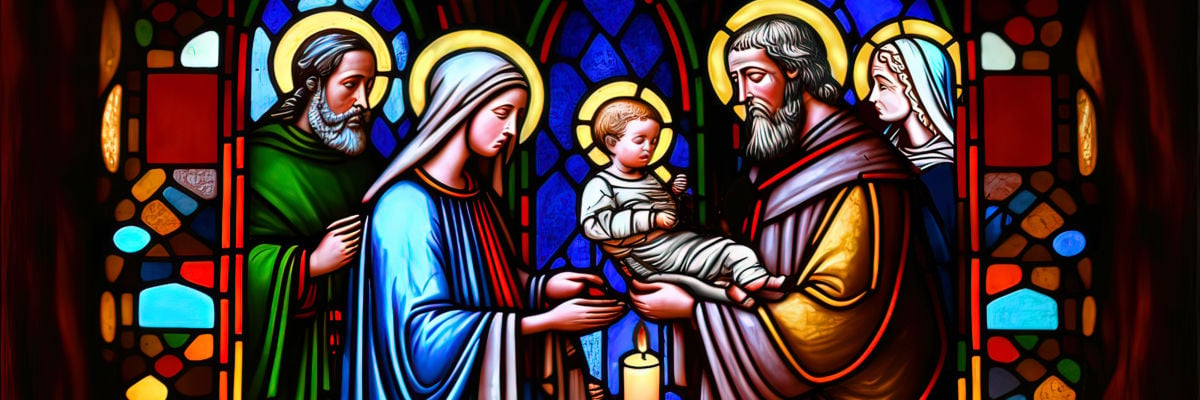
Under the Law of Moses, forty days after the birth of a son, a woman would offer a “sin offering” in the Temple (Lev. 12:1-4). And so today, forty days after Christmas, we celebrate the Feast of the Presentation. Since this is the final Christmas-related feast, it’s also when people began looking for signs of spring, a practice that gave rise to Groundhog Day.
What exactly is going on today? And why is it so important? We’ll start by explaining the deeply Jewish background of the Feast of the Presentation, because without that, it’s hard to make sense of any of it.
For instance, there’s an ongoing debate about whether the Holy Family was “middle class” or poor. Leaving aside the anachronistic nature of using “middle class” to describe anyone in the first century, the question is largely answered by Luke 2:24, which says that Mary’s offering in the Temple was “a pair of turtledoves, or two young pigeons.” What’s the significance of that? Ordinarily, a woman offered “a lamb a year old for a burnt offering, and a young pigeon or a turtledove for a sin offering” (Lev. 12:6). But “if she cannot afford a lamb, then she shall take two turtledoves or two young pigeons, one for a burnt offering and the other for a sin offering” (v. 8). In this case, the fact that Mary is offering two birds tells us that the Holy Family were poor enough that they couldn’t afford a lamb.
But we’ve just established that she’s offering a “sin offering” here in the Temple. Doesn’t that prove that Mary is a sinner, just like the rest of us? That’s how many Protestants read the passage. John MacArthur writes, “That Mary offered a sin offering is consistent with the reality that she was a sinner in need of a Savior. The Catholic dogma that Mary was immaculately conceived and lived a sinless life finds no support in Scripture.” And CARM’s Matt Slick asks, “If Mary was sinless, how could she also be unclean?”
So according to MacArthur and Slick, the Feast of the Presentation is all about Mary offering a sin offering to atone for the “sin” of . . . well, what, exactly? Giving birth to Jesus Christ? The obsession with trying to debunk the Catholic view of Mary has led these men into strange and impious places.
As you might have guessed, these Protestant objections are ignorant of the Jewish background to Luke 2. Let’s start with Slick’s question: “if Mary was sinless, how could she also be unclean?” Quite easily. Ritual impurity isn’t the same thing as being in a state of sin. As Jonathan Klawans explains in his book Impurity and Sin in Ancient Judaism, “sin does not produce ritual impurity, and ritual impurity does not render one sinful. Also ritual purification is not a part of the process of atonement.” Klawans further explains that ritual impurity is “generally natural and more or less unavoidable,” and “it is not sinful to contract these impurities.”
We see this distinction illustrated quite clearly in the parable of the Good Samaritan (Luke 10:25-37), in which the priest and Levite see a man on the road, wounded so badly that he appeared to be dead, and “passed by on the other side.” Why did they pass by? Because touching a dead body would render one ritually impure (Num. 19:13). By obsessing about ritual impurity, they were failing to treat the man with charity. Jesus is clear that the Samaritan, unconcerned with such matters, is the only one who treats the man lovingly.
This seems to be true even in terms of ḥaṭṭā’āṯ, the kind of offering traditionally translated (including here) as “sin offering.” Many scholars argue that a better translation is “purification offering,” since it’s offered for many things we wouldn’t think of as sins. For instance, it was offered at the dedication of God’s altar in Exodus 29:36-37. It was offered in the ritual purification of lepers and their houses (Lev. 14). If you took a Nazirite vow, which prohibited contact with dead bodies (Num. 6:6), and someone were to “die very suddenly” beside you, you offered a sin offering (v. 11). But if you successfully completed your vow, you also offered a sin offering (vv. 13-14).
After all, why would it be considered a “sin” to bring a child into the world? Jewish sources disagree, and some of the attempts at explanation are frankly far-fetched (for instance, the theory that women in childbirth always make rash vows never again to have sex with their husbands). One interesting theory, from the fifteenth-century Jewish commentator Isaac Abarbanel, argued “that this sacrifice is not due to her own sin, rather due to the sin of the mother of all (Eve), because if she did not sin, then man and woman would procreate not with desire and lust but in a totally natural way,” and that “because the branches are corrupted like the root is corrupted, and therefore the Torah requires a sin offering to atone for the primal sin.” In other words, both lust and the pain of childbirth are reminders of the Fall (Gen. 3:16), and so the sin offering is a recognition of what we Catholics would call “original sin.”
Whichever side you fall on in the ongoing debate about the ḥaṭṭā’āṯ offering, there’s a crucial detail that the Protestant commentators (and many others) are missing: Mary didn’t have to offer the ḥaṭṭā’āṯ “sin offering” in the first place. That’s true regardless of what you believe about Mary’s sinlessness, so long as you believe what the Bible teaches about the Virgin Birth. That’s because Leviticus 12 doesn’t apply to women who conceive (hārâ) or are pregnant (hārê). It applies to women who “receive seed” (zāraʿ). And while Mary did conceive and bear a child, she did so as a virgin, as St. Matthew tells us: “Behold, a virgin shall conceive and bear a son, and his name shall be called Emmanuel” (Matt. 1:23; cf. Isa. 7:14).
Under the strict terms of the Mosaic Law, Mary was totally free. She needn’t have offered the ritual offerings in the Temple, and she would have known that (since she knew she was a virgin). And yet there she is at the Temple for the Feast of the Presentation anyway. Why? St. Bede the Venerable (672-735) offers an insightful answer:
Mary, God’s blessed mother and a perpetual virgin, was, along with the son she bore, most free from all subjection to the Law. The Law says that a woman who “had received seed” [Lev. 12:2] and given birth was to be judged unclean and that after a long period she, along with the offspring she had borne, were to be cleansed by victims offered to God. So it is evident that the law does not describe as unclean that woman who, without receiving man’s seed, gave birth as a virgin. Nor does it teach that she had to be cleansed by saving sacrificial offerings. But as our Lord and Savior, who in his divinity was the one who gave the law, when he appeared as a human being, willed to be under the Law . . . so too his blessed mother, who by a singular privilege was above the Law, nevertheless did not shun being made subject to the principles of the Law for the sake of showing us an example of humility.
Bede, who clearly understands the nuances of Leviticus 12 better than many modern Protestants, realizes that it doesn’t apply (by its own terms!) to a virgin birth. Instead of the Presentation showing that Mary was a sinner who needed to atone for the “sin” of Jesus’ conception and birth, Luke 2 actually shows—and St. Paul reinforces in Galatians 4—that Mary freely submitted to the Jewish Law even when she was free from its strictures . . . just as her divine son would go on to do throughout his life.



